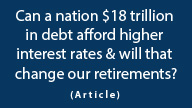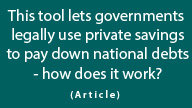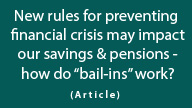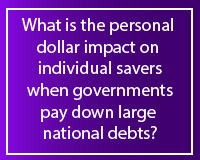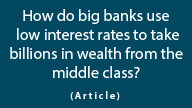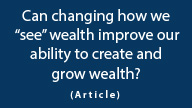Is There A “Back Door” Method For The Government To Pay Down The Federal Debt Using Private Savings?
By Daniel R. Amerman, CFA
Below is the 2nd half of this article, and it begins where the 1st half which is carried on other websites left off. If you would prefer to read (or link) the article in single page form, the private one page version for subscribers can be found here:
3) Funding By Financial Institutions (Fence #1). With this component of Financial Repression, the government establishes incentives for financial institutions such as banks, savings and loans, credit unions and insurance companies to hold substantial amounts of government debt. This can be publicly phrased as "mandating financial safety", instead of the more accurate description of mandating that investments be made at below-market interest rates to help overextended governments recover from financial difficulties.
This funding is sometimes described as a hidden tax on financial institutions, but let me suggest that this perspective misses the important part for you and me. Which is that as financial institutions operating within a country are effectively subsidizing this liquidation of government debt by accepting less than the rate of inflation on interest rates, the gross revenues of all financial institutions are depressed, and therefore less money can be offered to depositors and policyholders.
Then, because financial institutions make their money not on gross revenues, but on the spread between what they pay out and take in, then arguably, the guaranteed annual loss in purchasing power is not absorbed by the financial institutions, but rather passed straight through to depositors and policyholders, i.e. you and me, as further explained here.
The goal of this third element is to make sure that all savers are lending to the government at artificially low interest rates – even though the great majority of them never directly purchase a government security. One way of doing this is savers making deposits which pay very low rates of return, with banks using those very low cost deposits to purchase government debt that also pays a very low rate of return.
While little remarked upon, that is exactly what has been happening on a multi-trillion dollar scale in the United States, as part of the Federal Reserve's Quantitative Easing program. This can be clearly seen in the graphs below:


The Federal Reserve has purchased about $2.4 trillion in US Treasuries at extremely low interest rates – and it has financed these purchases by borrowing about $2.4 trillion from US banks at (on average) even lower interest rates. Which the banks are financing by paying virtually no interest rates at all to depositors.
On a net basis, the banks and the Fed drop out of the middle, and savers are left financing the US Treasury, with essentially no interest income gained, and an annual reduction in the value of the investment principal within an environment of ongoing inflation. This is a classic example of Financial Repression on an effective basis, even if the specific tools being deployed take a different form this time than they did in the postwar example.
4) Capital Controls (Fence #2). In addition to ongoing inflation that destroys the value of everyone's savings and thereby the value of the government's debts, while simultaneously making sure that interest rate levels lock in inflation-adjusted investor losses on a reliable basis, there is another necessary ingredient to Financial Repression: participation must be mandatory. Or as Reinhart and Sbrancia phrase it in their description / recipe for Financial Repression, it requires the "creation and maintenance of a captive domestic audience" (underline mine).
The government has to make sure that it has controls in place that will keep the savers in line, while the purchasing power of their savings is systematically and deliberately destroyed. This can take the form of explicit capital and exchange controls, but there are numerous other, more subtle methods that can be used to essentially achieve the same results, particularly when used in combination.
This can be achieved through a combined structure of tax and regulatory incentives for institutions and individuals to keep their investments "domestic" and in the proper categories for manipulation, as well as punitive tax and regulatory treatment of those attempting to escape the repression. A carrot and stick approach in other words, to make sure that investor behavior is controlled.
For a modern example, we can go back to the Affordable Care Act and one crucial element that was slipped in there with zero public debate. That is FATCA, which has been changing the flow of capital for US citizens on a global basis. FATCA makes it dangerous for foreign institutions to deal with US savers and investors.
They are forced into onerous reporting requirements on the financial activity of US citizens that could be administratively difficult to do, and require changing their internal procedures on a wholesale basis. If they don't comply in exactly the way that the US government wants – then these foreign institutions face potentially severe penalties.
So what are a lot of foreign institutions around the world doing?
They're not allowing US citizens to open accounts. The easiest and most risk-free thing for the bank to do is to simply not open the accounts. Which is effectively a form of capital controls.
Extraordinary Timing
The timing of events in the last few years is fascinating.
When did Quantitative Easing 2 (QE2) appear with the Federal Reserve's overtly taking control of US medium and long-term interest rates, forcing rates ever lower beneath the rate of inflation?
It was November 2010.
When did the surge in bank asset reserves begin with QE2, with an ever greater percentage of bank assets going to the Fed, which used the money to acquire very low- rate US government debts?
That was 2010.
When was FATCA made a matter of law, fundamentally reducing the ability of US citizens to move their money out of the country (albeit not to become effective until 2014)?
That was 2010.
With no press releases, and after an absence of about four decades, three of the core components of Financial Repression almost simultaneously were brought back into play (with the fourth component – inflation – having been there the entire time). Even while federal debt was soaring when measured as a percentage of the economy, returning to levels not seen in almost 60 years. Indeed, debt levels have not been this high since the last time Financial Repression had been used.
Coincidence?
5) Precious Metals Controls (Fence #3). Now there is a fifth component that is very important as well. This one's a little more optional, but it's part of classic Financial Repression in the United States as well as the UK and other nations.
And that is if the government is creating inflation, and as a matter of law it's not allowing citizens the ability to protect themselves from that inflation, then investors will be tempted to seek refuge in precious metals.
So the fifth component of classic Financial Repression is to either make illegal or discourage investment in precious metals. To some extent that's already true in the US when we look at our collectibles tax treatment as compared to other investments, which strongly penalizes investments in precious metals, as explained here.
At this stage, there have been fewer changes with regard to precious metals than with the other categories of Financial Repression. However, it is worth keeping in mind that the more successful precious metals investors are in dodging Financial Repression – then the more likely the return to Financial Repression for precious metals investors. After all, the underlying theory is based upon not allowing savers to escape the pen.
A "Low Drama" Approach To Systematically Cheating Investors
The governments of the world are in deep financial trouble, and would naturally prefer to avoid the "High Drama" approaches of overt global defaults, very high rates of inflation, or comprehensive austerity coupled with massive tax hikes – if possible. For each of those radical routes is highly unpopular, and could lead to political turmoil that would remove the decision makers and the special interests who support them from power. A more subtle approach sounds far more attractive, particularly since it has worked before over a period of decades, with an almost boring lack of political turmoil.
To get out of trouble by way of Financial Repression, the governments must wipe out most of the value of their debts, without raising taxes to the degree needed to pay the debts off at fair value. In other words, they must cheat investors on a wholesale basis. There is nothing accidental going on here, all that is in question are the particulars of the strategies for cheating the investors, meaning the collective savers of the world.
Again, the time-honored and traditional form that heavily-indebted governments use to cheat investors is to devalue the currency. Create inflation, and tax collections will rise with that inflation but the debts won't, and meanwhile the savers of the world will be paid back in full with currency that is worth less than what was lent to the governments in the first place.
Except that there is the technicality, according to one currently popular school of investment theory, that all-knowing and all-powerful free markets will demand that interest rates will necessarily rise above the rate of inflation, so that the value of savings is not eroded.
From the governmental perspective, this is demonstrably a rather absurd theory. The core point of the Reinhart and Sbrancia paper is that to pay down government debt, the advanced economies of the world quite effectively squeezed an average of 3-4% annually out of investor real net worth for a period of 25 years, using a wide assortment of overt and less overt controls over interest rates and investor behavior.
When many people think of inflationary dangers, they think of high rates of inflation, perhaps 10% per year or more. They take a "High Drama" approach, and think that if rates of inflation are more moderate, then there isn't that much to worry about.
Ironically, however, this belief could not be more mistaken, for what history shows is something else altogether. "Moderate" rates of inflation have historically been quite effectively used over a period of decades to redistribute wealth from individual savers to national governments on a massive scale with virtually no political costs – because the general public has no idea what is being done to them so long as it is done relatively slowly and subtly, and they aren't reading about it in the paper.
Leaving The Flock
Difficult though it may seem, there is a way to beat Financial Repression. How?
Succinctly phrased: the first step is to stop thinking like a sheep and start thinking like a shepherd.
Stop acting like a sheep, and change your financial profile so that it aligns with the objectives of the "shepherds", which are the governments of the world.
Instead of fighting the governments of the world, position yourself so that the greater the mispricing between inflation and artificially low interest rates – the greater your real wealth grows, in inflation-adjusted terms.
The fundamentals of Financial Repression are for governments to pin down their citizens, force them to take interest rates that are below the government-induced rate of inflation, and make it almost impossible for an older investor with a conventional financial profile to escape. This is a time to "fight the good fight" politically – but not with your savings or your future standard of living.
Instead, align your financial interests with the government. So that the more outrageous that government actions become in squeezing the value of investor savings from their populations, and the more unfair that low interest rates become and the longer they persist – the more reliable the compounding of your wealth becomes for you, and the greater the growth in your financial security.
So how does one stop thinking and acting like a sheep? This can be amazingly simple, or it can be impossibly difficult. It is you and the perspective you choose that will determine whether thinking like a shepherd will become simple or be impossible. How open are you – truly – to changing the way you view investments and financial security?
Can you change the personal paradigm that may have shaped your financial worldview for decades?
View the investment world in the conventional way that most of us have been taught, and then maintaining wealth over the coming years of inflation and Financial Repression is likely to be extraordinarily difficult, particularly in after-tax and after-inflation terms. Because everything around you really is set up for sheep shearing.
This is not conspiracy theory talk – it's how the world really worked between 1945 and the 1970s. As has been studied in-depth by economists around the world since then, for 25+ years most advanced western nations used Financial Repression, it worked, and it worked without the general public ever catching on. Policymakers around the world thus likely see variants of this subtle and proven debt reduction methodology as their best way out.
The Great Sheep Shearing of the early 21st century has already been in process since 2010; we're just using some different names and specifics this time around. And a very strong similarity with the previous round – indeed, an indispensable similarity from a political perspective – is that the average person in the street once again has no idea.
Oh, people are aware that the interest rates they are earning on deposits and money market funds are pathetically low. They also know that government debts have reached fantastic, almost incomprehensible levels. But the connection between those two – and how it may transform the value of their savings and their realized investment returns for decades – most savers likely have no understanding of that.
Lacking knowledge, they lack defenses.
This lack of knowledge and lack of defenses means that Financial Repression will likely succeed with the overwhelming majority of investors – much like it did before only on a more thorough basis, because the problems are far larger this time around.
Whether Financial Repression will successfully prevent another and perhaps even larger round of financial crisis is a different question. But regardless, the attempt is still likely to dominate markets as well as government regulations and policy for years and possibly decades to come.
Your alternative is to accept the world as it is, take personal responsibility for your own outcome, and educate yourself. You can seek to fundamentally change your paradigm, even turn it upside down – and personally turn that same world of interest rates being held below the rate of inflation into a target-rich environment of wealth-building opportunities.
It is all up to you.
 What you have just read is an "eye-opener" about one aspect of the often hidden redistributions of wealth that go on all around us, every day.
What you have just read is an "eye-opener" about one aspect of the often hidden redistributions of wealth that go on all around us, every day.
 A personal retirement "eye-opener" linked here shows how the government's actions to reduce interest payments on the national debt can reduce retirement investment wealth accumulation by 95% over thirty years, and how the government is reducing standards of living for those already retired by almost 50%.
A personal retirement "eye-opener" linked here shows how the government's actions to reduce interest payments on the national debt can reduce retirement investment wealth accumulation by 95% over thirty years, and how the government is reducing standards of living for those already retired by almost 50%.
 An "eye-opener" tutorial of a quite different kind is linked here, and it shows how governments use inflation and the tax code to take wealth from unknowing precious metals investors, so that the higher inflation goes, and the higher precious metals prices climb - the more of the investor's net worth ends up with the government.
An "eye-opener" tutorial of a quite different kind is linked here, and it shows how governments use inflation and the tax code to take wealth from unknowing precious metals investors, so that the higher inflation goes, and the higher precious metals prices climb - the more of the investor's net worth ends up with the government.
 An "eye-opener"
tutorial of an entirely different kind is linked here, and it shows how much of what the public believes to be true about stock market history - is merely an illusion, which also just happens to facilitate the redistribution of wealth.
An "eye-opener"
tutorial of an entirely different kind is linked here, and it shows how much of what the public believes to be true about stock market history - is merely an illusion, which also just happens to facilitate the redistribution of wealth.







If you find these "eye-openers" to be interesting and useful, there is an entire free book of them available here, including many that are only in the book. The advantage to the book is that the tutorials can build on each other, so that in combination we can find ways of defending ourselves, and even learn how to position ourselves to benefit from the hidden redistributions of wealth.


